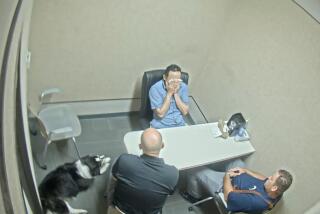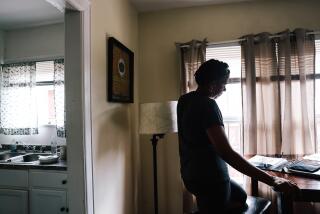High-Tech Blood Test Used to Link Peyer, Knott
- Share via
A test that checks for genetic markers matched a blood spot on a boot worn by Cara Knott to the blood type of former California Highway Patrol Officer Craig Peyer, a blood expert testified Wednesday.
Additionally, the sophisticated test showed that Knott’s killer probably was a member of a blood group that is found in less than 1% of the Caucasian population, he added.
Gary Harmor, a serologist with the Serological Research Institute in the Bay Area, said that Peyer is included in the same blood group as the probable killer.
The test for genetic markers, which prosecutors say link Peyer to Knott’s murder, were observed by a defense serologist when they were performed in December.
Peyer, a 13-year CHP veteran, is charged with killing Knott, 20, on Dec. 27, 1986. Police said she was strangled after a struggle on the old U.S. 395 bridge near Interstate 15 and the Mercy Road off-ramp between 9 and 10 p.m. Her body was thrown 65 feet into a dry creek bed, where it was discovered by police the next morning.
Few Labs Do Genetic Tests
Fewer than 10 of the estimated 400 crime laboratories in the United States are capable of performing the genetic tests on blood and semen specimens, Harmor said. The tests use “absorption inhibition” to identify antigens in blood that are called Gamma and Kappa markers (Gm and Km). The markers are genetic in nature and have unique identifying characteristics.
Using charts and a series of mathematical formulas, Harmor said that the Km, Gm and other genetic markers detected on the blood found on Knott’s boot and in Peyer’s blood are found in only 0.62% of the world’s Caucasian population, or 1 in every 161 people.
“My conclusion was that Mr. Peyer could have donated that bloodstain (on the boot),” Harmor said.
Defense attorney Robert Grimes briefly cross-examined Harmor but failed to shake him or his statistics.
Harmor said that he tested the blood spot on the boot in December, 1987, one year after Knott was killed, and also tested a penny-sized blood spot on Knott’s sweat shirt at the same time. According to Harmor, he circled more than 50 blood spots on the sweat shirt but found only one that matched Peyer’s Type A blood. All the others matched Knott’s Type O.
Spot on Sleeve
The tiny spot that matched Peyer’s blood was found on the left sleeve, where it meets the neck, Harmor said. The Km and Gm test done on this spot was less extensive than the test done on the boot because fewer genetic markers were available, he added. Nevertheless, the test showed that the blood spot on the sweat shirt had the same Km and Gm formula as Peyer’s blood.
Using less genetic information, the test on the sweat shirt showed that the donor of the suspected blood spot came from a blood group of 1.3% of the Caucasian population, or 1 in 75 people, Harmor said.
Earlier Wednesday, another in a line of surprise witnesses who have testified at Peyer’s trial said that she saw Peyer pull over a light blue Volkswagen at Mercy Road on the night that Knott was killed. Knott was driving a white Volkswagen when she died.
Michelle Martin, a counselor for emotionally disturbed children, identified Peyer as the CHP officer she saw pull over the Volkswagen. Without blinking an eye, Martin, who said she worked previously in public relations and as a security guard, pointed at Peyer and identified him as the CHP officer she saw make the nighttime stop. She is the first witness to identify Peyer on Mercy Road that night.
Throughout her testimony, Martin repeatedly said that she saw Peyer pull over a light blue station wagon, and would quickly correct herself. “I mean Volkswagen,” she said after each statement.
Identification Questioned
Martin’s identification of Peyer was called into question by defense attorney Grimes when she testified that she was able to identify Peyer even though there was no lighting along the shoulder of Interstate 15 and the Mercy Road off-ramp on the night that she allegedly saw him stop the Volkswagen. But the woman said that, as she drove past Peyer’s car, “I got a good side look at him.”
Grimes pressed Martin on how she could drive past Peyer’s patrol car on the freeway, at night, and still recognize his face when there was no illumination available.
“I don’t know. I’m not a cinematographer,” Martin said. “So, I don’t worry too much about lighting.”
During her testimony, Martin mentioned several times that she saw Peyer stop “her,” but she was never asked whether she could identify the driver of the car that Peyer allegedly stopped.
Martin said that she decided to step forward and testify more than a year after the killing after she heard another surprise witness testify on Friday that he saw a CHP cruiser stop a light-colored Volkswagen at Interstate 15 and the Mercy Road off-ramp. According to Martin, she tried several times after the killing to get the police interested in her story, but they never returned her calls.
Contacted District Attorney
Finally, after Robert Calderwood testified on Friday, she called the district attorney’s office on Monday to tell investigators there what she saw.
Like Calderwood, Martin said that she remembered the stop because she considered it unusual. Her testimony closely paralleled Calderwood’s.
“As it (Volkswagen) was about to stop . . . the loudspeaker on the patrol (car) said to the effect, ‘Don’t stop there. Go down the ramp,’ ” Martin said. “I thought it was awfully strange that he would tell it to continue on.”
Peyer’s command to the Volkswagen made her curious, Martin said, and she slowed down to look.
“I looked to what was going on and saw the officer’s face,” she said. Later, when she was being questioned by Grimes, Martin volunteered:
“As you can see, there was no reason for him (Peyer) to tell her to continue on.”
According to Martin, she saw Peyer on a television newscast on Dec. 29, 1986--two days after Knott was killed--and told her parents: “That’s the cop I saw last night.”
When she heard that Peyer had been arrested on Jan. 15, 1987, she made the first of several futile phone calls to police, Martin said. Finally, she said that she “got fed up with the bureaucratic runaround and I said, ‘Screw it.’ ” She did not try to contact authorities again until Monday, when she called the district attorney’s office.
Before talking to prosecutors on Monday, Martin said that she had not told anybody outside of her family that she had seen Peyer on the night that Knott was killed.
“I didn’t want people to go around saying that I’m nuts or looking for attention,” she said.
Jeanne Martin, Michelle’s mother, also testified and supported her daughter’s account of events. But Jeanne Martin also contradicted portions of her daughter’s testimony.
Michelle Martin said that she distinctly remembered the night she saw Peyer because she was driving her father’s Ford Falcon truck. She was doing about 55 m.p.h. on the freeway and driving in the slow lane, Martin said, because the truck would overheat if driven faster.
But Jeanne Martin said that her husband’s truck has a “296 engine” that never overheats.
She “always follows the news closely. All of it,” Jeanne Martin said. But when Grimes asked her if she and her family had been following the Knott case closely, Jeanne Martin said they had not.
More to Read
Sign up for Essential California
The most important California stories and recommendations in your inbox every morning.
You may occasionally receive promotional content from the Los Angeles Times.













